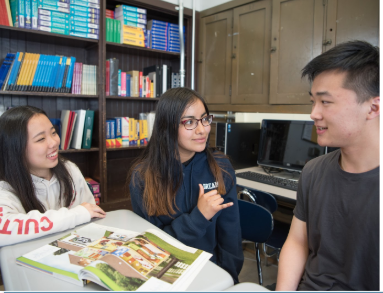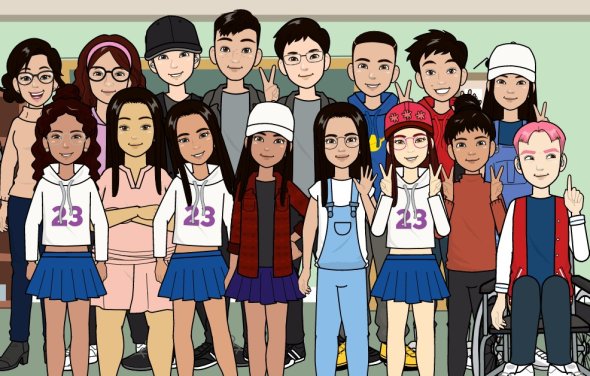
STUDENTS: Grow your English this Summer
This summer improve communication skills in Math, Social Studies, Science, English & Computer Science classes, advocate for your community, earn high school credits, make friends, play games, & get wellness support!

SAILL Curriculum
Students engage in an interdisciplinary curriculum grounded in the belief that our multilingual newcomer students are uniquely empowered to translate the assets and needs of their communities to outside stakeholders looking to support. See Below for Sample Curriculum
What is SAILL?
The Summer Academy for Integrated Language Learning (SAILL) is a five-week summer program dedicated to providing newcomer multilingual students an opportunity to earn additional high school credits, continue developing their English language skills, and access socio-emotional supports during the summer. Throughout the summer, educators with diverse backgrounds and experience collaborate and refine their instructional practices in service of multilingual learners. Students are eligible to enroll in SAILL if they have entered the U.S. school system within the past 3 years (newcomer and developing English Learners) and have demonstrated emerging or expanding levels of English proficiency on the English Language Proficiency Assessment of California (ELPAC). The program accepts rising 9th-12th graders. While students share the experience of being recent immigrants, their language backgrounds, ethnicities, years in the U.S. country of origin, and experience with formal schooling vary. The SAILL program is an opportunity that allows students’ language skills and confidence to grow while earning credits in core humanities, math, and science towards graduation, and also provides teachers with a learning lab to hone their craft of integrating language and content instruction.
Learn more about SAILL
Learn more about SAILL's principles, curriculum, student outcomes, and how students and teachers can apply to join our program.
SAILL's Five Core Principles
SAILL was launched ten years ago as EL Village and has evolved over time; however, five core principles have anchored the design of the program each year.
- Collaboration through meaningful student to student interaction: Students learn language best when they have frequent, scaffolded opportunities to use language (Castellón et al., 2015; Garcia et al., 2011). We engage in cross visitation and video sharing of classroom practices to support meaningful student interaction by sharing common structures like group roles, participation routines, and calibrating our reflections on a common rubric.
- Strategic language and content integration: Students learn language most effectively when it is placed in a rich context which they can explore with their teacher and classmates (Castellón et al., 2015; Garcia et al., 2011). In the SAILL curriculum, language development work is not separate from the content work of the class, but rather a part of it. Language goals are included along with content goals, and teachers will be supported with curriculum to help the students reach these goals.
- Curriculum that is grounded in real-world application of learning: Educators work to empower students to see language weaving across content to gain a deeper understanding across subject areas and in turn apply that knowledge to understand their own lives and power. Their summer of learning culminates in a student showcase where students present their learnings and advice to community stakeholders.
- Supporting the whole child with wellness supports and counseling: SAILL acts as a bridge between wellness providers in the previous school year to the next school year. In addition, in-depth analysis of students’ transcripts takes place over the summer by experienced counselors who then meet with each student individually to review and explain needed coursework.
- Educators strengthen and practice their instructional leadership skills through regular opportunities for collaboration within a distributed leadership framework: Recruitment and retention of an effective teaching cadre in service of multilingual learners has many challenges: teachers’ lack of experience integrating language and content, lack of formal training in bilingual education methodologies or SLA theoretical frameworks, etc. (Banegas, 2012; Fillmore & Snow, 2000; Gandara et al, 2005. Over the summer teachers take on leadership roles to lead collaboration and inquiry in these design principles to then be able to share their discoveries with their teams in the regular school year.
SAILL Outcomes
The major outcome of the SAILL program is the improvement of EL students’ on-track status towards graduation. This is achieved by their earning of up to 10 credits towards graduation. SAILL also aims to improve students’ English language proficiency, reading and writing skills. All students will demonstrate grade-level proficiency on an interdisciplinary project, as well as a coded video game.
Based on research conducted in 2017 by Angela Sun through a partnership with Stanford University, EL summer programming demonstrated an impact on improved graduation outcomes for English Learners district-wide after several years of implementation. Prior to EL Village, the graduation rate for English learners was 69.1% and three years later it climbed to 74.1% (Gottesfeld & Fong, 2018). This initial research suggested a significant impact on student learning; however, the program will be examined with a more rigorous analysis over the next 4 years through an early phase grant funded by the Education Innovation and Research grant. This study will evaluate the implementation and one-year impacts of SAILL and document the program for replicability.
Student Registration
Students should speak with their home school counselor to register. Registration is open from March 1st-May 1st. View the email that eligible students received.
Educator Recruitment
Educators interested in teaching, counseling, coaching and supporting in SAILL should apply through the OASIS bulletin below. Reach out to Program Administrator Lauren Ponti for more information, pontil@sfusd.edu
SAILL Curriculum
We have developed an interdisciplinary curriculum grounded in the belief that our multilingual newcomer students are uniquely empowered to translate the assets and needs of their communities to outside stakeholders looking to support. With this in mind we focused on developing our students' skills to become historians, data analysts, digital artists, and activists through an interdisciplinary project that asks students to present their learning on the historical and current context of education for English Language Learners through summarizing, graphing, and programming in order to support their own recommendations for how to better support newcomer students at our schools in SFUSD. An overview of SAILL with links to the curriculum and resources we have developed can be found on this SAILL resource overview page.
This page was last updated on May 29, 2024

